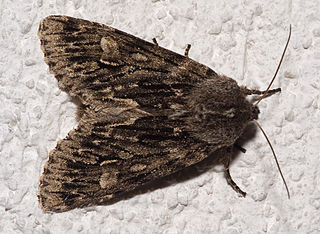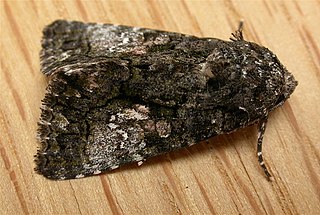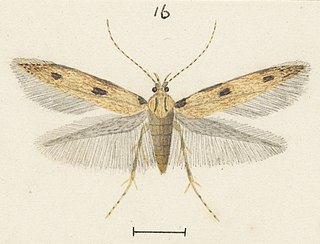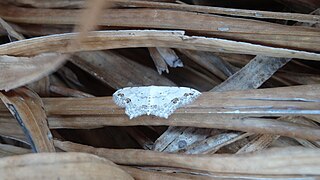
The mottled beauty is a moth of the family Geometridae. The species was first described by Carl Linnaeus in his 1758 10th edition of Systema Naturae.

Thera variata, the spruce carpet, is a moth of the family Geometridae. It is found throughout Europe, North Asia and Japan. The common name spruce carpet is also used when referring to Thera britannica.

Brachionycha nubeculosa, the Rannoch sprawler, is a moth of the family Noctuoidea. It is found across the Palearctic from the British Isles in the west, across central and northern Europe over Russia, Siberia to China. The species is only locally distributed in central Europe, but is often relatively common in this region. In southern Europe, the occurrence is limited to some mountainous regions. In Germany, it reaches as far as the summit regions of the low mountain ranges. The species is moisture loving and prefers moist, cool temperate forests, mixed forests, wooded valleys, river and stream edges as well as orchards.

Aedia leucomelas, the eastern alchymist, sweet potato leaf worm or sorcerer, is a moth of the family Noctuidae. It is found in large parts of the world, ranging from Europe all over Asia up to Japan and some African countries. The subspecies Aedia leucomelas acronyctoides is found in Australia.

Mesapamea secalis, the common rustic, is a moth of the family Noctuidae. The species was first described by Carl Linnaeus in his 1758 10th edition of Systema Naturae. It is found in Europe, north-west Africa, Turkey and northern Iran.

Mythimna decisissima is a moth of the family Noctuidae first described by Francis Walker in 1856. It is found from India across south-east Asia including Hong Kong, Japan, Taiwan and Australia in Queensland and New South Wales. It is also present in South Africa.

Trigonodes hyppasia, the triangles or semi-looper, is a moth in the family Erebidae. The species was first described by Pieter Cramer in 1779. It is largely cosmopolitan, found throughout Borneo, Fiji, India, Nepal, Sri Lanka, São Tomé and Príncipe, Taiwan, Thailand, Zimbabwe, northern Australia, and almost all African countries.

Leucania loreyi, the cosmopolitan, false army worm or nightfeeding rice armyworm, is a moth of the family Noctuidae. It is found in most of African countries, the Indo-Australian subtropics and tropics of India, Sri Lanka, Myanmar, the eastern Palearctic realm, and the Near East and Middle East. The species was first described by Philogène Auguste Joseph Duponchel in 1827.

Urapteroides astheniata is a moth of the family Uraniidae first described by Achille Guenée in 1857. It is found in south-east Asia, from India, Sri Lanka to Fiji, including New Guinea and the tropical north of Australia.

Platyptilia isodactylus is a moth of the family Pterophoridae found in China, Europe and was introduced to Australia and New Zealand for biological control. It was first described by the German entomologists, Philipp Christoph Zeller in 1852.

Eublemma cochylioides, the pink-barred eublemma, is a species of moth of the family Erebidae described by Achille Guenée in 1852.

Creatonotos gangis is a species of arctiine moth in South East Asia and Australia. It was described by Carl Linnaeus in his 1763 Centuria Insectorum.

Tiracola plagiata, the cacao armyworm, is a moth of the family Noctuidae. The species was first described by Francis Walker in 1857. It is found from south-east Asia, South India, Sri Lanka, Myanmar to the South Pacific Islands, including the northern two-thirds of Australia.

Xyloryctidae is a family of moths contained within the superfamily Gelechioidea described by Edward Meyrick in 1890. Most genera are found in the Indo-Australian region. While many of these moths are tiny, some members of the family grow to a wingspan of up to 66 mm, making them giants among the micromoths.

Labdia anarithma is a moth of the family Cosmopterigidae. It was described by Edward Meyrick in 1888. It is found in New Zealand and throughout Australia. Adults are on the wing from December to March and are day flying. They have been collected by sweeping bracken fern.

Scopula pulchellata is a moth of the family Geometridae. It is found in the Indo-Australian tropics, from India, Sri Lanka to Taiwan and the Solomon Islands, as well as in Africa.
Heterochyta is a genus of moths of the family Xyloryctidae.
Heterochyta asteropa is a moth in the family Xyloryctidae. It was described by Edward Meyrick in 1906. It is found in Australia, where it has been recorded from Queensland.
Heterochyta infesta is a moth in the family Xyloryctidae. It was described by Edward Meyrick in 1906. It is found in Australia, where it has been recorded from Victoria.
Heterochyta xenomorpha is a moth in the family Xyloryctidae. It was described by Edward Meyrick in 1906. It is found in Australia, where it has been recorded from Western Australia.















